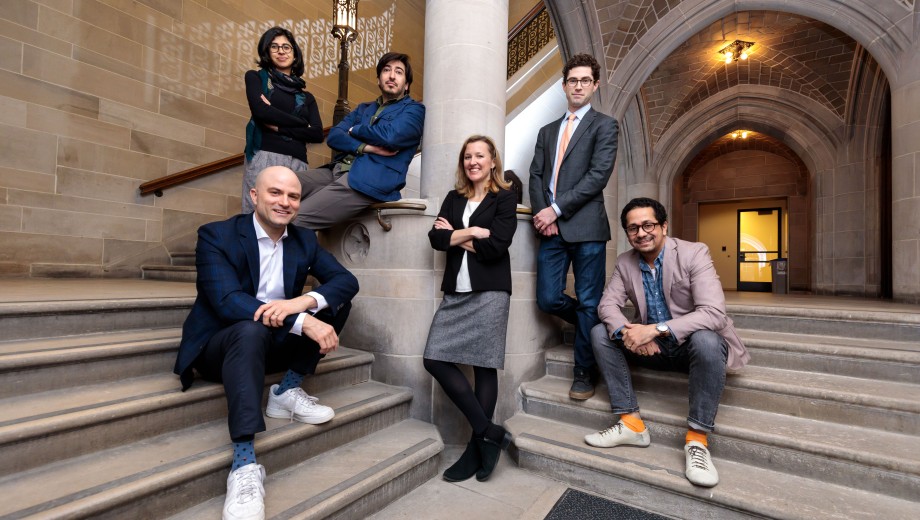English Language and Literature is the largest department in the Division of the Humanities. Such a big program could get unwieldy, or lopsided, but Deborah Nelson, the Helen B. and Frank L. Sulzberger Professor in English and department chair, has kept a balance, in seniority and rank as well as disciplinary specialization. Her efforts have given UChicago arguably “the most diverse English department in the country, not just in terms of our demographics, but also our field interests—preserving the traditional fields and expanding into new ones.”
English’s disciplinary breadth has allowed the department’s junior scholars to follow a variety of paths before settling in to specialized subfields that span centuries. Sonali Thakkar, one of six assistant professors interviewed for this piece, came to the discipline through a parallel interest in international relations, when she realized “many questions of transitional justice—memory and memorialization, reparation and redistribution, the retelling of history—were issues of narration and storytelling.” She began studying postcolonial literature, “which often takes up issues of how to reconstitute politics and society after violence and conflict.” She’s now completing a book on postwar conceptions of race and their influence on anticolonial and postcolonial thought.
Benjamin Saltzman—having just completed a book on secrecy in the early Middle Ages—has begun a new project that also examines violence, particularly the physical act of “looking away,” from antiquity through the late Middle Ages. “It’s remarkable as a gesture because it can mean all these different things—shame, grief, mourning, disgust, and even the irrepresentability of emotion itself” in literature and visual art. The project began with a narrow focus on early medieval England, but his colleagues within and beyond English inspired him to expand to other regions and eras.
The concept of disgust is key to Zachary Samalin’s scholarship as well. His book, near completion, traces the history of disgust throughout the Victorian nineteenth century. He feels fortunate that the “department has a remarkable group of faculty whose work focuses on the nature of emotion and affect,” saying that even if he were appointed elsewhere, “these are the people whose work I would be drawing on.”
Julie Orlemanski’s recent book explores medical understandings of the body in the Middle Ages, which evolved into a new project on “fictional bodies—bodies that are emerging from voices and text.” She’s also fascinated by the development of fiction as a concept: “What does it mean to theorize fiction for earlier time periods, or for literary cultures that don’t necessarily have the same categories as ours?”
An influx of junior faculty over the past five years has helped cultivate a “real intellectual community,” notes Samalin. “I’m continually amazed, not only by how talented and creative my junior colleagues are, but by how warm and supportive they are.” Saltzman describes a rare environment “where everyone’s invested in each other’s success,” defined by what Orlemanski calls “an essence of shared conversation and shared intellectual stakes.”
Integrating assistant professors into the department requires thoughtful mentorship, Nelson notes. “I try to titrate their involvement, but at the same time they’re really full-fledged colleagues.” While assistant professors need time to develop their own research and teaching, Nelson explains, it’s crucial to consult them regarding faculty appointments and graduate admissions: “When you hire someone for their particular insight and ability to navigate their field, you want their input! They are the experts, and you don’t have the option of not using their expertise.”
Timothy Harrison agrees: “It’s very collaborative, not competitive. And from day one, you’re very involved in the life of the department, so you feel like a full member as opposed to someone on the periphery.”
Harrison’s forthcoming book is on poetry’s influence on the nascent understanding of consciousness in the late seventeenth century. His follow-up project considers how sixteenth-and seventeenth-century poets engaged with the emerging modern concept of life by using it to structure their characters’ first-person experience of expending effort—“animating” the concept in a particular time and place.
Like his first book, this next one will be developed in response to his colleagues’ critiques on early drafts. “One of the things that I really appreciate about this place,” he explains, “is the generosity and the rigor of engagement.”
Edgar Garcia observes, “Our department has so much intellectual heterogeneity—doing different kinds of things from different angles. I’m always learning from my colleagues for that reason.” A poet as well as a scholar, Garcia embodies that heterogeneity. He just completed his first book, on the contemporary legacy of indigenous sign systems, and his next project is on the relationship between divination and human migration.
He says that the entire department is “committed to the project of intellectual conversation.” The collaborative ethos transcends subfields, flourishing, as Orlemanski puts it, “no matter what period or archive people are working on.”
“That all sounds very ‘school spirit,’” says Garcia with a laugh, “but it’s true.”

